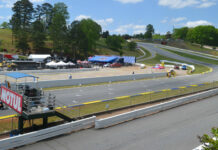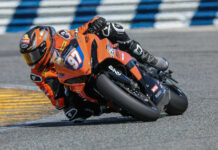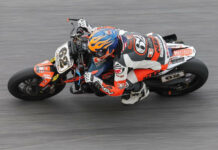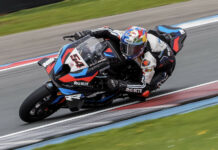Superbike & Supersport World Championships, Superstock FIM Cup Changes to the Rules The Superbike Commission, composed of Messrs Paolo Flammini (FGSport), Claude Danis (FIM) and Giulio Bardi (Team representative), unanimously decided to introduce the following modifications to the Road Racing Superbike & Supersport World Championship and Superstock FIM Cup Regulations (for immediate application see also Press Releases published on February 17, April 13, April 23 and August 30, 2005 the updated rules can be consulted on the FIM website, Rules & Codes, Road Racing, Superbike & Supersport Regulations) : Sporting Rules 1.11 Entries 1.11.1 “¦ The Superbike and Supersport tyre development teams approved by the FIM and FGSport must designate, amongst their testing circuits, the circuits nominated by the Official Tyres Supplier. 1.11.3 .ii) “¦ Teams must make every reasonable effort to provide a qualified substitute rider, approved by FIM and FGSport, to fulfil their entry obligations. However no substitution or replacement of the entered rider may be made after 14h00 on the day preceding the first practice session of the event, except in Superbike, when the limit is at 9h00 on the day preceding the race. 1.19 Start Procedure 1) Only riders who have completed at least one sighting lap will be permitted to start the race from their position published on the final grid. Under no circumstances may they push onto the grid from the pit lane. 2) Approximately 20 Minutes”¦. Riders may complete more than one sighting lap by passing through the pit lane where they may make adjustments, change machines or refuel. 4) “¦ Riders starting the warm up lap from the pit lane must start the race from the back of the grid. 12) “¦ All riders must be in position on the grid with engines running. No further assistance from mechanics is permitted. Any rider who is unable to start his machine must remove it to the pit lane, under the control of the grid marshals, where he may make further attempts to start it or change machine. Such riders may start the warm up lap from the pit lane and will start the race from the back of the grid. 13) 2 Minutes before the Start of the Race Green flag waved to start the warm up lap. 1.20 Ride Through Procedure During the race, the rider will be requested to ride through the pit lane, stopping is not permitted. He may then rejoin the race. 1.23.2 Flags Which Convey Information and Instructions: # Yellow Flag “¦ Shown waved at the flag marshal post, this flag indicates that there is a danger ahead. The riders must slow down and be prepared to stop. Overtaking is forbidden up until the point where the green flag is shown. Any Infringement of this rule during a practice session will result in the cancellation of the time of the lap during which the infraction occurred. In case of infringement of this rule during the race, the rider must go back the number of positions decided by the Race Direction. The penalty will be first communicated to the team and then a board will be displayed for the rider on the finish line during a maximum of 3 laps. If the rider did not go back after the board has been presented 3 times, he will be penalised by a ride through. In both cases, further penalties (such as fine – suspension) may also be imposed. If immediately after having overtaken, the rider realises that he did an infraction, he must raise his hand and let pass the rider(s) that he has overtaken. In this case, no penalty will be imposed”¦ 1.26 Interruption of a Race 1.26.1 If the Race Director decides to interrupt a race due to climatic conditions or some other reason, then red flags will be displayed at the finish line and at all marshals’ posts and he will switch on the red lights around the circuit. Riders must immediately slow down and return to the pit lane. “¦. Riders who do not enter the pit lane, riding on their motorcycle, within 5 minutes after the red flag has been displayed will not be classified. 1.27 Re-starting a Race that has been interrupted 1.27.4 Conditions for the re-started race will be as follows: i) In the case of situation described in 1.26.2 (less than 3 laps completed) above: a. All riders may re-start. b. Motorcycles may be repaired or changed. Refuelling is permitted. c. – For Superstock, the number of laps will be two-thirds of the original race distance rounded down to the nearest whole number of laps. – For Superbike and Supersport, the number of laps will be the same as the original race distance. d. The grid positions will be as for the original race. ii) In the case of situation described in 1.26.3 (3 laps or more and than less two-thirds completed) above: a. Only riders who are classified as finishers in the first race may re-start. b. Motorcycles may be repaired or changed. Refuelling is permitted. c. – For Superstock, the number of laps of the second race will be the number of laps required to complete two-thirds of the original race distance rounded down to the nearest whole number of laps with a minimum of 5 laps. – For Superbike and Supersport, the number of laps of the second race will be the number of laps required to complete the original race distance. “¦ Technical Rules Superbike 2.4.2 Minimum Weights “¦At any time of the event, the weight of the whole machine (including the tank) must not be less than the minimum weight with a tolerance of 1 kg. 2.4.6.4 Rear Suspension Unit Rear suspension unit can be changed but a similar system must be used (i.e. dual or mono). The rear suspension linkage may be modified or replaced. The original fixing points in the frame (if any) must be used to mount the shock absorber, linkage and rod assembly fulcrum (pivot points). 2.4.6.8 Foot Rest/Foot Controls Foot rest/foot controls may be relocated, but the original mounting points must be used. “¦ Non folding footrests must have an end (plug) which is permanently fixed, made of plastic, TeflonÃ’ or equivalent type of material (min. radius of 8mm). The plug surface must be designed to reach the widest possible area of the footrest. The Technical Director has the right to refuse any plug not satisfying this safety aim. 2.4.6.10 Fairing/Body Work e) The lower fairing should incorporate one hole of 25 mm in the bottom of the front lower area. “¦ 2.4.6.11 Fuel Tank “¦All fuel tanks must be filled with fire retardant material, or be fitted with a fuel cell bladder. “¦ The fuel tank must be securely fixed to the frame. The fuel tank must be fixed rigidly to the frame from the front and from the rear (no bayonet coupling is allowed to body parts). The Technical Director has the right to refuse a bike if he is of the opinion that the fuel tank fixation is not safe. 2.4.6.14 Air Box The air box may be altered or replaced from those fitted to the homologated motorcycle (a special design for racing is allowed). If fuel injectors are attached to the cover of the air box, their position must remain as original. 2.4.6.17 Fuel Supply The fuel injection management computer chip (EPROM) may be changed. The use of flash memory (“flash RAM”) is allowed. Fuel pump and pressure regulator may be modified or changed. Fuel lines may be replaced. The fuel line(s) going from the fuel tank to the carburetion instruments must be located in such a way they are protected from possible defects. 2.4.6.19 Cylinder Head “¦ *1000 cc Three and Four cylinder machines: Aftermarket or modified valves, springs, retainers and other valve train components are permitted. The original number of valves must be maintained. a. Valve diameters, including stem, must remain as homologated. b. Valves must be made of the same basic material as the homologated valves. c. Valves must remain in the homologated location and at the same angle as the homologated valves, except for normal valve maintenance. 2.4.6.29 Crankcase/Gearbox housing and lateral covers “¦ Lateral (side) covers may be altered, modified or replaced. If replaced, the cover must be made in material of same or higher specific weight of the substituted cover. 2.4.6.30 Transmission/Gearbox All transmission/gearbox ratios, shafts, drums, selector forks are free”¦ 2.4.6.34 Exhaust System Exhaust pipes, catalytic converters and silencers may be altered or replaced from those fitted to the homologated motorcycle. The number of the final exhaust silencer(s) must remain as homologated. The silencer(s) must be on the same side(s) of the homologated model”¦. Supersport 2.5.2 Minimum Weights “¦At any time of the event, the weight of the whole machine (including the tank) must not be less than the minimum weight with a tolerance of 1 kg. 2.5.6.6 Brakes “¦ Front and rear brake callipers as well as all the mounting points and mounting hardware (mount, carrier, hanger) must remain as originally produced by the manufacturer for the homologated machine. (correction to match with French text). 2.5.6.8 Foot Rest/Foot Controls “¦ Non folding footrests must have an end (plug) which is permanently fixed, made of plastic, Teflon® or an equivalent type material (minimum radius 8mm). The plug surface must be designed to reach the wider possible area. The Technical Director has the right to refuse any plug not satisfying this safety aim. 2.5.6.12 Seat “¦ Holes may be drilled in the seat or rear cowl to allow additional cooling. Holes which are bigger than 10mm must be covered with metal gauze or fine mesh. Mesh must be painted to match the surrounding material. 2.5.6.21 Camshaft “¦ At the technical checks: for direct cam drive systems, the cam lobe lift is measured; for non direct cam drive systems (i.e. rocker arms), the valve lift is measured. 2.5.6.29 Cylinders “¦ Homologated materials and castings for cylinders must be used. The surface finish of the cylinder bore must remain as homologated. 2.5.6.35 Exhaust System Exhaust pipes and silencers may be modified or changed. Catalytic converters may be replaced or removed. The number of final exhaust silencer(s) must remain as homologated. The silencer(s) must be on the same side(s) of the homologated model”¦ Superstock 2.7.2 Minimum Weights “¦At any time of the event, the weight of the whole machine (including the tank) must be not be less than the minimum weight, with a tolerance of 1 kg. 2.7.6.2 Front Forks “¦ Standard original internal parts of the forks may be modified. After market damper kits or valves may be installed. 2.7.6.7 Tyres The rider can use a maximum of four (4) front and four (4) rear DRY weather tyres for each event”¦. 2.7.6.8 Foot Rest/Foot Controls “¦ Non folding footrests must have an end (plug) which is permanently fixed, made of plastic, Teflon® or an equivalent type material (minimum radius 8mm). The plug surface must be designed to reach the wider possible area. The Technical Director has the right to refuse any plug not satisfying this safety aim. 2.7.6.13 Wiring Harness The original wire-loom may be modified as indicated hereafter: The unused wire loom elements supplying current to direction indicators, horn, ignition contact and key-lock, etc, may be unplugged and/or removed (no cutting is allowed). 2.7.6.21 Camshaft No modifications are allowed. At the technical checks: for direct cam drive systems, the cam lobe lift is measured; for non direct cam drive systems (i.e. rocker arms), the valve lift is measured. The timing of the camshaft is free, however no machining of the camshaft sprocket is authorized. 2.7.6.33 Ignition/Engine Control System The fuel injection management computer chip (EPROM) may be changed. The central unit (ignition/engine control unit/CDI) must stay as homologated, but the software can be changed. An additional control unit to change the fuel mixture may be installed and must be fitted to the original connectors. Fuel, Oil and Coolants 2.10.1.2 Unleaded petrol will comply with the FIM specification if: (a) It has the following characteristics: Property Units Min. Max. Test Method RON 95.0 102.0 ISO 5164 MON 85.0 90.0 ISO 5163 Oxygen % m/m 2.7 ASTM D 5622 ASTM D 4815 (1) Nitrogen % m/m 0.2 ASTM D 4629 Benzene % v/v 1.0 EN 238 RVP kPa 90 EN 12 Lead g/l 0.005 EN 237 (2) Density at 15°C kg/m³ 720.0 775.0 ASTM D 4052 Oxidation stability minutes 360 ASTM D 525 Existent gum mg/100 ml 5.0 EN ISO 6246 Sulphur mg/kg 5 ASTM D 5453 Copper corrosion rating C1 ISO 2160 Distillation: E at 70°C % v/v 22 50.0 ISO 3405 E at 100°C % v/v 46.0 71.0 ISO 3405 E at 150°C % v/v 75.0 ISO 3405 Final Boiling Point °C 210 ISO 3405 Residue % v/v 2.0 ISO 3405 Appearance Clear and bright Visual Inspection Property Units Min. Max. Test method Olefins % v/v 18.0 ASTM D 1319 (3) Aromatics % v/v 35.0 ASTM D 1319 (3) Total diolefins % m/m 1.0 GCMS/ HPLC Disciplinary and Arbitration Code 3.3.4.3 Authority and Competences The CDI will hear any appeals against decisions taken by the FIM Stewards. The CDI adjudicates upon request of the Race Direction or the FIM Steward Panel. After a meeting, the President of the FIM, the Executive Board or the Management Council may, within 5 days, refer to the CDI all matters of violation or infringement to the FIM regulations. 3.4.1 Right of protest No protest may be lodged against a decision of statement of fact of the Race Direction to inflict or not: # a change of position # a ride through # a disqualification from the practice sessions or races by means of a black flag or black flag with orange disc.
Revisions To The 2006 FIM World Superbike, Supersport And European Superstock Rules
Revisions To The 2006 FIM World Superbike, Supersport And European Superstock Rules
© 2005, Roadracing World Publishing, Inc.






